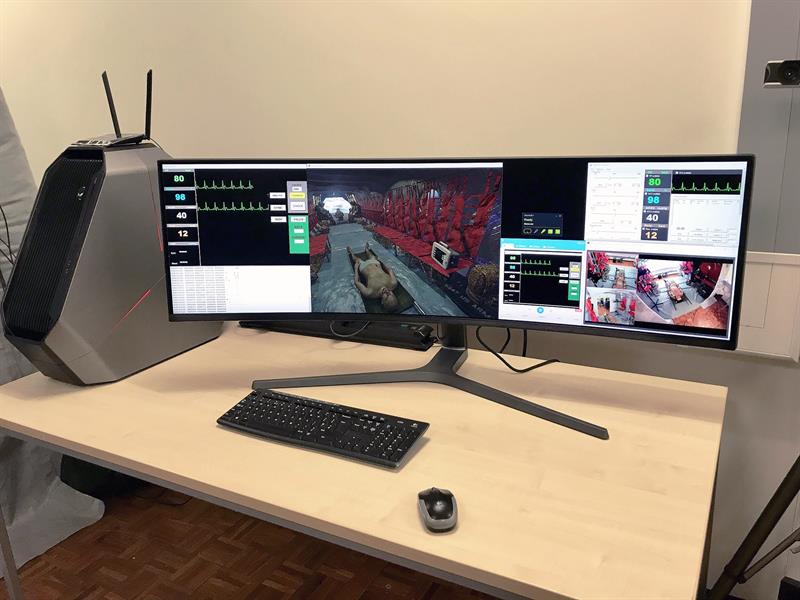Over the last 30 years, we’ve seen 3 hype waves, promising that ‘this is the year for VR/AR’.But according to Bob Stone, Director, Human Interface Technologies Team at the University of Birmingham and Fellow of the Chartered Institute of Ergonomics and Human Factors: “Today’s market is just like the 1990s, littered with false promises. The difference? There’s just a bit more hope now.”
Talk of virtual shopping, education and gaming dominated the 90s, and significant investment into branches of VR were made as a result. “Unfortunately, the technology launched wasn’t fit for purpose,” Stone explained, “and a lot of money was squandered.”
Rebecca Gregory-Clarke, Head of Immersive at Digital Catapult, believes its slow evolution is owed to the previous limitations of the technology – noting it was “cumbersome and expensive”. As such, she explains it was restricted to academic research institutions and labs which could facilitate it both in terms of space and cost. But, with recent and significant progress made in displays and computing power, Gregory-Clarke believes new opportunities have arisen within this space.

Released earlier this year, standalone VR devices offer a virtual wireless experience, with all the components built into the headset. This is a step up from the tethered headsets and mobile VR previously introduced and, according to Gregory-Clarke, is one of the biggest leaps the technology has seen. “There’s a lot of research going into tracking – that is 6 degrees of freedom (6DoF) – and into new forms of gesture control, but there’s still much to be developed,” she admits.
Qualcomm is among those companies developing technology to accommodate for 6DoF – the ability to walk around in a virtual environment. With its Snapdragon platform, Hugo Swart, Head of extended reality (XR) at Qualcomm, said it has enabled 6DoF with simultaneous localisation and mapping (SLAM) – a technology that constructs and updates the digital map of an environment while also keeping a track of where the user is within the location.
“The UK is going to play a big part in the creation of VR/AR content.” Rebecca Gregory-Clarke |
To make this possible, the standalone device features a camera which allows high dynamic range video (HDR) capture. The system compares these HDR images at set periods of time and calculates movement based on that comparison. This means the system can determine whether the user took, for example, a step backwards, and create a realistic set of visuals that depict this movement.
Swart points to the advancements made in processors as one of the keys to unlocking the standalone device. “They need to be able to handle the workloads, rendering and visuals of a VR system,” he explained. Consequently, Qualcomm has developed ‘foveated rendering’ a technique based on the human eye. “When we look at something it’s in focus but our peripherals aren’t,” said Swart. “We apply the same concept so that what the user is focused on is in high resolution, but the rest is in a lower resolution. This saves GPU compute, but maintains great quality for the end-user.”
The Snapdragon chip contains a series of processing units including a GPU, CPU, an image processor, a DSP and a sensor hub. To minimise latency, the way in which these elements are connected was “re-architected”, explained Swart. And now, with the rise of 5G, Qualcomm is looking into how it can improve it further.
“We introduced the concept of boundless XR at our 4G/5G summit,” said Swart. “The rendering will be split between the headset and edge of the network, where the data will be compressed and sent back to the headset over 5G for final processing.”
The main challenge Swart sees in VR/AR is actually content. But, he notes this is a growing and improving area. “With any new ecosystem it’s a snowball effect. You start small and get a certain number of users who provide you with content. As more join, more content is created.” He compares it to the smartphone. “To begin with there weren’t a lot of features, but as they gained popularity, industry saw better devices and more apps.”
“Britain is going to have a big part to play in developing content because of its strong creative design and manufacturing industries,” Gregory-Clarke added.
Stone remains cautious. “We’re seeing a lot of optimistic expensive market survey reports which, to be honest, aren’t worth the paper they’re written on. There’s lots of technology, but it’s being brought to market at an immature status,” he contended. “People are buying them, believing what they read online and suddenly finding – like in the 90s – they’re not delivering.”
Stone points to misleading online videos as part of the problem. “There’s so many examples of so-called AR/VR being used in surgery, but it’s not. It’s just special effects on videos that’s convinced the public it’s real.
“Companies aren’t seeing growth or a lot of return – and they’re not likely to anytime soon,” he continued. “We have a lot of start-ups over ‘hyping’ what the technology can do in order to get cash flow through the door.”
He describes the market as experiencing ‘blips’, with the hype encouraging investment and optimistic attitudes, but does admit that the technology is moving in the right direction, becoming cheaper and more capable over the last decade.
“The number of applications and new UK companies emerging in this space is growing,” said Gregory-Clarke, “and the maturity of the products they’re producing is increasing, which is encouraging to see. We are also hearing a lot of success stories.
“But it’s not without its problems,” she countered. “On the consumer side uptake has been slower than some predictions. I think it’s important for industry to take a long-term view on this. The devices of today aren’t going to be the devices in 5 years’ time, but that doesn’t mean we shouldn’t be experimenting and learning new skills.”

Instructor station used alongside VR simulator developed by Birmingham University to help support the UK armed forces medical emergency response team |
“Looking back to 2016, I think the expectations may have been too optimistic,” agreed Swart. “But a lot of progress has been and is being made. I don’t think we should see it as a marathon. It’s a journey.”
Looking to the future, Swart envisions the smartphone becoming a pair of virtual glasses. “VR/AR will be the way people consume content. It will be our entertainment, the way we work and the way we socialise. But that isn’t a one-year transition, it will take time.”
While Stone holds out hope for a revolution in wearable equipment. “I hope to see something where you can explore, taste and smell in the virtual world, without being encumbered by these crazy wearables we currently have.” He points to healthcare as the main driver for the technology, with palliative and end of life care benefiting the most from virtual experiences – but for that to happen, he maintains that an extreme leap in content and hardware capability is needed.
What Swart, Gregory-Clarke and Stone do agree on is that VR/AR is here to stay – how long it will take is debatable.
“I want to see people become more critical of technology,” concluded Stone. And perhaps he’s right. Despite there being more hope for the technology than ever before, maybe we all need to take a step back, remain a bit more cautious and be a little more patient.













